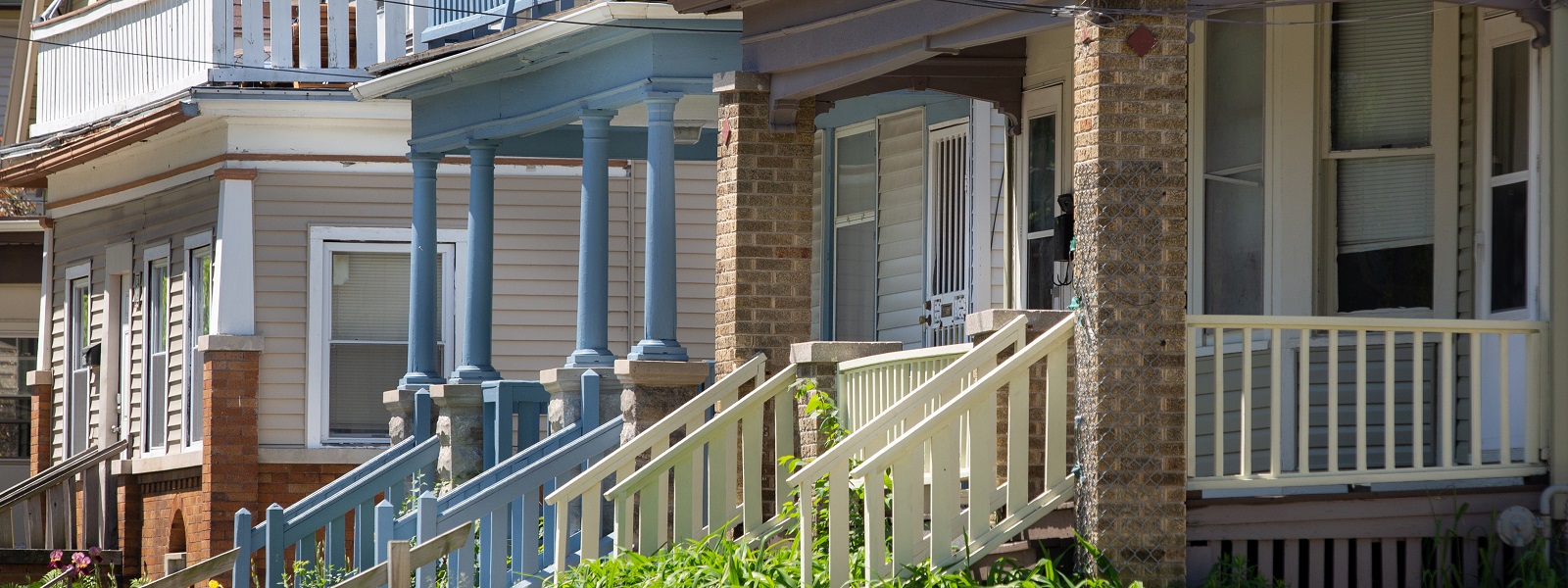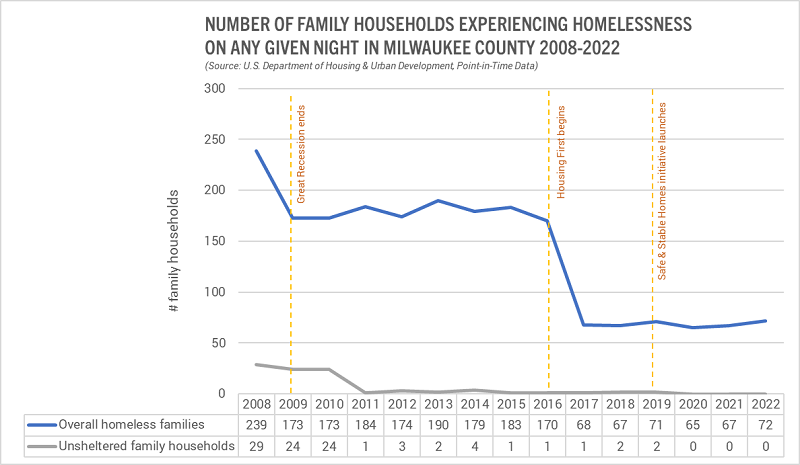Safe & Stable Homes: Where Are We Now?

May 17, 2023
Our mission is to end family homelessness by the end of 2023.
Written in collaboration with: Krystina Kohler, Portfolio Manager – Financial Stability
Families experiencing homelessness must feel invisible to most people. Systems are difficult to navigate for parents. Prevention programs are underfunded. Stigma keeps children silent. The reality is that family homelessness exists pervasively.
In Wisconsin, one-third of the population experiencing homelessness are families – families with at least one child under the age of 181.
Typically, more than 5,000 students are reported as homeless in our own four-county footprint2, and around 40-50 families enter shelters each month.
 Homelessness is devastating for every member of the family. Young children staying in shelters have a higher risk for developmental, behavioral, and educational challenges, adding to the stress and depression that their parents face3. One mother staying in a shelter noted how hard this has been for her daughter, who had just begun to walk, “When we got to [shelter], she was so unfamiliar with her surroundings that she didn't really feel safe to walk. So, she stopped.”4
Homelessness is devastating for every member of the family. Young children staying in shelters have a higher risk for developmental, behavioral, and educational challenges, adding to the stress and depression that their parents face3. One mother staying in a shelter noted how hard this has been for her daughter, who had just begun to walk, “When we got to [shelter], she was so unfamiliar with her surroundings that she didn't really feel safe to walk. So, she stopped.”4
Her child stopped walking.
After developing a plan with cross-sector experts in 2018 and 2019, United Way of Greater Milwaukee & Waukesha County launched our Safe & Stable Homes initiative, with the goal to ensure family homelessness is prevented whenever possible, or if it can’t be prevented, it is a rare, brief, and one-time experience.
In short: we stepped up to do what no other community in the nation has done. We are going to end family homelessness.
It’s an audacious goal, but with the help of community partners, corporations, government, and local citizens, we know we can do it. Prevention programs that are used in our Safe and Stable Homes initiative include:
- Eviction Free MKE – provides a family that is at or below 200% of the federal poverty guidelines free legal support needed to effectively manage the eviction process.
- Family Flex Fund – moves families out of shelter and into their own apartment quickly through flexible financial support and housing case management, and gets families at risk of homelessness back on their feet immediately and effectively so they can avoid shelter altogether.
- Milwaukee Rental Housing Resource Center – connects those in need to the right resources of rent assistance, landlord and tenant mediation, legal aid, and housing search help. This resource is used by both landlords and tenants.
- School-based Housing Case Management – embeds housing case managers into our school system to provide wraparound supportive services for students and their families.
Ending family homelessness is about systemic change: changing the way systems operate so that when families experience homelessness, our systems can react faster and with more resources so that the family's experience with homelessness is brief and non-reoccurring. Supportive data shows the impact Safe & Stable Homes has had in Milwaukee County since our last economic downturn.

Unsheltered families in Milwaukee County dropped from an average of four families any given night in the decade leading up to Safe & Stable Homes (2010-2019) to zero families (2020-2022)5.
Families are still entering emergency shelters, but these episodes are becoming briefer. The average number of days a family experiences homelessness has decreased by 48% and the maximum length of time families spend in emergency shelter has decreased by 72%6.
The end of family homelessness in our four-county footprint is in sight, but that doesn’t mean our work will end. A tight housing market, continued inflation, and pandemic-related disruptions still being felt in family budgets ensure that housing insecurity will persist. Continued support of Safe & Stable Homes ensures that we identify every family in need, prevent every case of family homelessness that is possible to prevent, move families out of shelter and into their own homes quickly, and provide long-term wraparound supportive services so all families remain housed.
Housing is a human right. It doesn’t matter how big the house is. It matters that there is safety and stability in it. Together, we can help provide this stability and end family homelessness in our community. We believe that to live better, we must Live United.
Safe and Stable Homes collaborates with the U.S. Interagency Council on Homelessness (USICH) to meet their definition of ending family homelessness. United Way of Greater Milwaukee & Waukesha County has achieved progress in every overarching USICH goal7.
1 Institute for Community Alliances. 2019 Homeless Management Information System (HMIS) Report: The State of Homelessness in Wisconsin (v2, updated 9/25/2020), Household Types. Accessible here.
2 Wisconsin Department of Public Instruction, WISEDash Public Portal, Student Enrollment Data. Accessible here.
3 Desmond, Matthew and Rachel Tolbert Kimbro. "Eviction’s Fallout: Housing, Hardship, and Health." Social Forces, vol. 94 no. 1, 2015, p. 295-324. Project MUSE. Accessible here.
4 Lee, Michelle, et al. "Exploring Access and Utilization of Early Intervention Services Among Families Experiencing Homelessness: A Qualitative Study." Journal of Health Care for the Poor and Underserved, vol. 33 no. 4, 2022, p. 1865-1878. Project MUSE. Accessible here.
5 U.S. Department of Housing and Urban Development. CoC Homeless Populations and Subpopulations Reports, WI-501: Milwaukee City and County CoC. Accessible here.
6 From 7/2021 to 10/2022, according to Homeless Management Information System data, obtained from Impact Inc. and Institute for Community Alliances.
7 https://www.usich.gov/tools-for-action/criteria-and-benchmarks-for-ending-family-homelessness
Interested in supporting United Way's Safe & Stable Homes?
Click here to donate.
For more updates on Safe & Stable Homes and other United Way initiatives, follow us on Facebook, Twitter, Instagram, and LinkedIN.

Have something to say? LEAVE A COMMENT:
Your email address will not be published. All fields Required.
United Way of Greater Milwaukee & Waukehsa County blog and social media presence is designed as a source for information, sharing and collaboration about United Way and health and human service related topics. As part of our commitment to our readers, we expect all posters to abide by the following rules:
• Posts and comments should be on topic, conversational, and serve to educate or entertain
• Posts and comments may not be unlawful, fraudulent, threatening, libelous, defamatory, discriminatory, harassing, obscene or otherwise rude or in poor taste
• Posts and comments may not be used for any commercial purpose or otherwise to promote any outside organization or its activities
United Way of Greater Milwaukee & Waukesha County reserves the right, at our discretion, to remove any post or to revoke a user’s privilege to post to our page. Comments found to be in conflict with the guidelines above will be removed promptly.
Comments are not necessarily those of United Way of Greater Milwaukee & Waukesha County and its employees and we do not guarantee the accuracy of these posts.